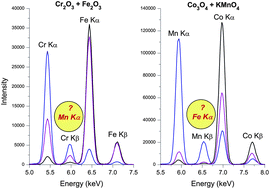Influence of chemical environment on the analysis of X-ray spectra of thick pellet samples containing 3d transition metal compounds
Abstract
Nowadays quantitative analysis in energy dispersive X-ray Emission Spectroscopy is usually performed by the “fundamental parameter approach”. Such an approach generally relies upon a good knowledge of fundamental physical parameters. As a rule none of the algorithms in use by laboratories performing routine analysis account for possible chemical effects on X-ray intensity ratios or energies. Here we tested the possible influence of such practice on reliability in the routine analysis of thick pellet samples containing transition metal compounds. A number of samples were prepared by mixing various proportions of MnO2, KMnO4, and Co3O4 (sets A–B) or Cr2O3, K2Cr2O7, and Fe2O3 (C–D). The samples were irradiated by 2 MeV proton beams and proton induced X-ray emission spectra were analyzed by a “fundamental parameter” approach using the GUPIXWIN code. The main interest has been to test the possibility of false Fe detection in the presence of large Mn and Co peaks (sets A–B) and/or Mn in the presence of large Cr and Fe peaks (sets C–D). The results of the analyses indicate false hits of Fe (sets A–B), and larger reported Mn concentrations than expected (sets C–D). However, in all the cases the reported concentrations for Fe or Mn are in between the limits of detection and quantitation. The influence of surface roughness and other effects have been discussed.


 Please wait while we load your content...
Please wait while we load your content...